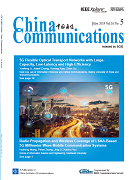COMMUNICATIONS THEORIES & SYSTEMS
Aijing Li, Chao Dong, Fan Wu, Shaojie Tang, Guihai Chen, Qihui Wu
2019, 16(5): 70-82.
Emerging techniques such as Wi-Fi direct makes the objective of always-on be true. People can easily chat and share files with nearby friends even without AP (Access Point) or cellular coverage. In this paper, we focus on the channel efficiency issue of AP-free Wi-Fi networks, which can be easily constructed in the subway, in a high-speed railway, or when camping in the wild. Today IEEE 802.11 DCF is the most commonly used MAC protocol for Wi-Fi networks, however, due to the control messages and backoff time, channel efficiency in high data rate networks can be extremely low. To solve this, we propose CD-MAC, which allows control messages to be transmitted with data packets concurrently, and thus eliminates the overheads of backoff and explicit contention. To maintain the reception reliability, we redesign the control messages and use signal detection in PHY instead of bits decoding to detect them. In MAC layer, CD-MAC is built upon our Correlation Detection based PHY. We have implemented and evaluated CD-MAC using USRP N210. Evaluation results show that CD-MAC can achieve over 95.5% channel efficiency and provide throughput gains of up to 80%, 60%, and 29.1% compared with DCF, 802.11ec, and back2F, respectively.
